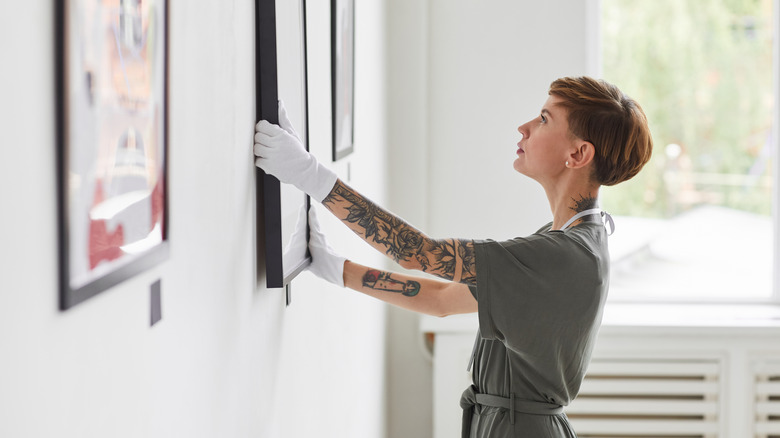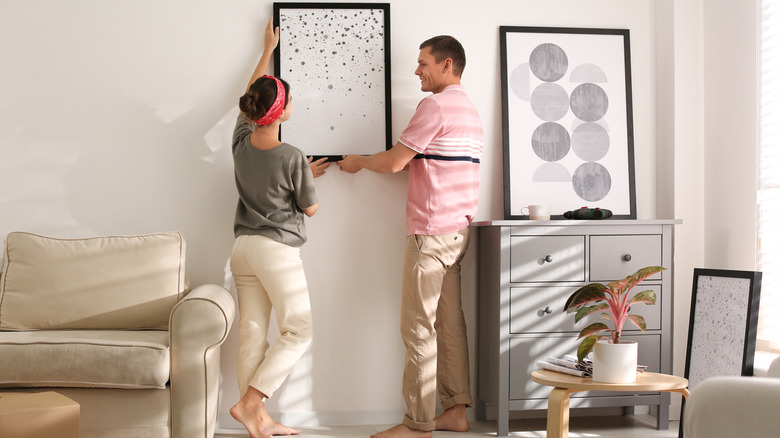Bobby Berk's Top Tip For Hanging Artwork On A Plaster Wall
Hanging art can be a bit stressful without having to worry about damaging the wall. Plaster walls are particularly vulnerable to crumbling if the wrong method is used with hardware or tools, so it's a good idea to have a plan. Fortunately, interior designer Bobby Berk from "Queer Eye" has some expert advice on how to hang art on almost any kind of wall, including plaster. The key, says Berk, if you're not drilling or hammering into a stud, is to use an anchor.
Berk also recommends using a wire to hang your framed artwork. "The biggest mistake is using one single nail or screw in the center," Berk says in an interview with Better Homes & Gardens. "It eventually warps and ruins your frames and gravity will cause them to fall apart." It's also important to do as much preparation as you can, in terms of placement of your artwork and measuring to make sure you have enough room, before doing any drilling or hammering into your wall. Then you can avoid making mistakes and having to make more holes than necessary.
Why you need an anchor
Hanging heavy items on a plaster wall can cause it to break or crack, which is why Bobby Berk recommends using an anchor. "If you're hanging into an older plaster wall, make sure you're putting a lot of good anchors in there," he says (via Better Homes & Gardens). Anchors come in a variety of sizes and materials, from plastic to metal, including a type called a toggle anchor — also known as a toggle bolt. Berk says the heavier the artwork, the more important it is to use an anchor: "If it's heavy enough, make sure you're putting an anchor in, period."
Anchor screws can be attached to hollow walls without causing damage. You can use a small drill to start a hole for anchors that work as screws, and there are also self-drilling anchors for use in drywall. Knowing the material your wall is made from is crucial when hanging artwork, according to Berk, and there are a number of workarounds for different kinds of walls. On an exposed brick wall, Berk suggests looking for cracks or holes in the mortar left by previous owners. "If you cannot find that, you need to get a mortar drill bit and drill a hole," Berk explains. "If you try to hammer it in there, you can crack the brick and damage it, and you don't want to do that. So make sure that you get a drill bit that's made for drilling into brick."
Fixing small holes in plaster walls
Despite your best efforts and precautions, you might still cause some damage to your plaster walls when using a drill or hammer to hang artwork. This damage can be fairly easy to fix if the holes or cracks are small. Bobby Berk recommends using spackle and a bit of sandpaper to repair any small holes. Spackle is a blend of gypsum (a soft chalky mineral) and materials for binding. It comes pre-mixed in small tubs that have a long shelf life if kept sealed and stored in a cool dry place. You will need a small putty knife, or another flat-edged tool, to apply the spackle to the hole then smooth it over so there are no bumps or wrinkles. Wait at least a half hour for it to dry then you can sand and paint over it as you wish.
The best way to prevent any damage to plaster walls from heavy artwork after they're hung is to use an anchor to secure hanging hardware and be sure the artwork has a wire that goes across the back. Hanging a piece of art using a single hook may cause stress on both the artwork and possibly on your walls.


